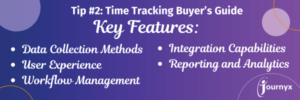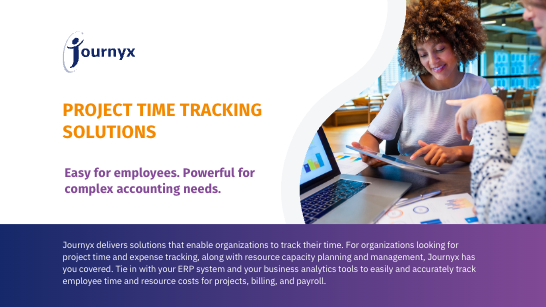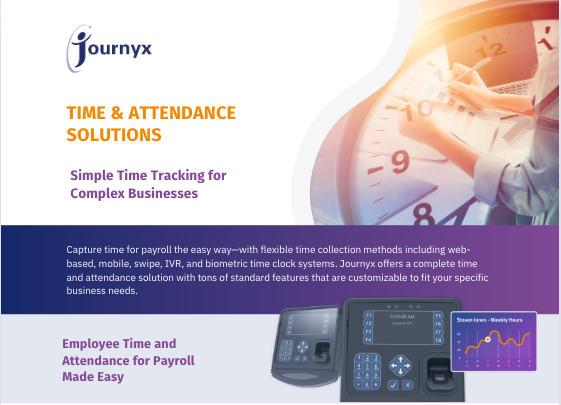The Ultimate Buyer’s Guide to Time Tracking Solutions
Choosing the Right Time Tracking Solution for Your Business
Selecting an advanced time tracking solution is a crucial decision that can significantly impact your business’ revenue capture, profitability, tax exposure, and workforce optimization. Whether you’re managing a remote, hybrid, or traditional workforce, a robust time tracking system can streamline operations, ensure compliance, and provide valuable insights. This guide will walk you through key considerations to help you choose the best solution for your needs.
Understand Your Business Needs
To find the right time tracking solution, start by analyzing your business needs. Every organization is unique, so it’s essential to first identify the most important business problems for your company.
- Current Processes: Review your current time tracking methods and pinpoint any limitations. This will help you understand what improvements are needed in a new system and provide a guide for measuring success.
- Departmental Input: Involve representatives from all major departments in this process. Their insights will help you identify the necessary features and avoid any potential pitfalls.
Compile your findings into a list of requirements, distinguishing between must-have features and nice-to-haves. This will serve as your reference point when evaluating different solutions.
Key Features to Look For
When comparing time tracking solutions, focus on the following critical features:
a. Data Collection Methods
- Web and Mobile Access: Essential for remote workers. Ensure the solution has a user-friendly mobile app with the same functionality as the desktop version.
- Biometric and RFID Time Clocks: Useful for on-site employees. These modern methods provide quick, accurate time capture.
- Automatic Time Tracking: Look for systems that integrate with the tools and systems employees use daily, such as calendars, project management tools, office productivity software, and location-based data. Using these tools to populate timesheets automatically reduces the burden of manual entry and improves accuracy. Using automatic time tracking can be especially helpful for monitoring hybrid & remote workforces, as it reduces the dependence on managerial monitoring.
b. User Experience
- Single Sign-On (SSO): Simplifies the login process across integrated systems, saving time and reducing frustration.
- Custom Rules Engine: Allows you to set rules for validating data, preventing user errors from the start.
c. Workflow Management
- Approval Processes: Flexible, multi-level workflows are crucial for accurate time tracking and approval. Where relevant, ensure the system can handle both timesheet-based and project-based approvals.
- Leave and PTO Tracking: The solution should make it easy to request and approve leave, and to track time against PTO balances.
d. Integration Capabilities
- Existing Systems: The time tracking solution should integrate with your ERP/accounting, payroll, project management, and HR systems. This ensures smooth data flow and minimizes manual work.
- Automated Time Tracking: Look for systems that can auto-populate timesheets using data from other business applications. This reduces errors and saves time.
e. Reporting and Analytics
- Real-Time Reporting: Choose a system with a powerful reporting engine that offers real-time access to data. This helps in making quick, informed decisions.
- AI-Assisted Data Analysis: Some solutions offer AI tools for analyzing time data, making gaining insights easier without complex reporting tools.
- Business Intelligence Tools Integration: Ensure compatibility with tools like Excel, PowerBI, or Tableau for advanced data analysis and reporting.
Customer Experience
Software is just a tool, and its value to you is dependent upon the overall experience you have with the vendor providing it. So, when you invest in a SaaS solution, it’s wise to explore how the vendor will deliver that solution to you and confirm whether it meets your organization’s needs.
a. Customer Care
- Setup Assistance: Review the vendor’s approach to setting up the solution, including any custom integrations; look especially for transparent, inclusive, and agile deployment processes, to minimize your organization’s time to value.
- Customer Support: Look into the vendor’s support services. Check their response times and customer satisfaction ratings to ensure you and your end-users will get the help you need.
b. Solution Confidence
- Performance and Reliability: Look for a cloud-based solution with at least 99.9% uptime and fast performance guaranteed by robust SLAs.
- Geographic Redundancy: Choose a provider with multiple data centers for failover and compliance with data residency requirements like GDPR.
- Scalability: The system should easily handle growth in users and data volume without performance issues.
- Updates: Select a provider that offers easy, transparent updates to keep your software current with the latest features and security patches.
- Disaster Recovery: Verify the presence of a solid disaster recovery plan, including regular backups and rapid data restoration capabilities.
c. Regulatory Compliance
- Industry Standards: Make sure the solution can help you comply with relevant regulations such as various wage laws, DCAA, HIPAA, or SOX. This often involves accurate time and cost accounting features.
- Data Security: Check if the vendor undergoes regular SOC audits and meets SSAE 21 Type II standards for robust security.
- Privacy Laws & Standards: The laws regarding privacy change rapidly, both in the US and especially in the EU. Confirm that the solution meets the standards of your organization, looking especially for compliance with GDPR, EU-U.S. Data Privacy Framework, and the Swiss-U.S. Data Privacy Framework.
d. Ease of Doing Business
- Dedicated Account Representative: Ensure the vendor provides a dedicated account representative as your single point of contact for routine communications, ensuring continuity and a deeper understanding of your specific needs and relationship.
- Executive Access: You should have the opportunity to connect with higher-level executives for strategic discussions and feedback.
- Transparent Pricing: Pricing should be clear with no hidden fees. Look for a vendor that offers flexible plans to accommodate your growth.
- Customer Feedback Loop: A good provider will have mechanisms for gathering and acting on customer feedback, ensuring your needs are continuously met.
- Onboarding and Training: Access to comprehensive onboarding and training resources helps you get up to speed quickly and efficiently.
- Customer Testimonials & References: Consult online review sites, testimonials on the vendor’s website, and request references from existing customers, so you can hear directly from your peers about their experiences and satisfaction with doing business with the vendor.
Conclusion
Choosing the right time tracking solution is a game-changer. It’s not just about logging hours, but is a way of gaining insights, improving efficiency, and making smarter decisions. With the right tool, you can streamline operations, support your team, and drive your business forward.
So, as you weigh your options, keep these tips in mind. And when you’re ready to explore a solution that checks all the right boxes for your business, consider Journyx.
Want to learn more? Click here or shoot us an email at [email protected]. Let’s make time tracking work for you!
Journyx helps you track time for projects, payroll, and more. Learn how Journyx can help you use time to your advantage in your business.





